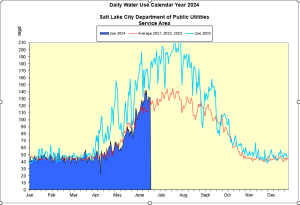Water Conservation FAQ
From where do we get our water and to where is it delivered?
Salt Lake City is the retail water provider for all of Salt Lake City, as well as portions of Millcreek, Cottonwood Heights, Holladay, Murray, Midvale, and South Salt Lake. Salt Lake City holds direct water rights for 60-70% of the water supply. Salt Lake City receives wholesale water from the Metropolitan Water District of Salt Lake and Sandy and the Central Utah Water Conservancy District. These wholesale providers convey and store Salt Lake City’s share of federal water projects, including the Central Utah Project and the Provo River Project.
How much water is used annually in Salt Lake City Department of Public Utilities' service area?
In 2022, SLCDPU delivered 81,634 acre feet (AF) of water.
How much water have we saved?

As of June 19, 2024, we have used 10,385 million gallons of water. We are 0.84% above 2023 use for this same period. This increase represents 87 MG more water used compared to 2023 for the same time period.
What types of customers receive water?
SLCDPU service area is diverse and ranges from single-family residential customers to heavy industrial customers, and everything in between. We also provide water to a variety of institutional customers, such as government properties (municipal, county, state, and federal), schools, and churches. Following is a breakdown of the various sectors we serve:
Residential: 53%
Commercial: 23%
Industrial: 6%
Institutional: 18%
What is our gallons per capita day (GPCD)?
Gallons per capita day (GPCD) is a number that reflects the relationship between treated water delivered within a service area divided by a census population for that area. It is not a measure of how much water an individual uses, but rather how much water a community needs per person to meet all of its needs each day, including the water needs for businesses, restaurants, hospitals, hotels, schools, churches, parks, industry—every way a community uses water.
Within our service area (including SLC, Mill Creek, Holladay, Cottonwood Heights, and the other areas where we provide water), our gpcd is 165. The new Utah State Regional Goal for our region is 187 by 2030.
Are we still in a drought?
Yes, even with the snow we received during the 2022-2023 winter, we are still in a drought. It will take many years of comparable snowpack to replenish water needs for the natural environment, to refill reservoirs, and to return the Great Salt Lake to a healthy level. And, given that we never know what the coming winter will bring, it is always important to use our water resources wisely by using it efficiently and without waste. Click here to learn more about water conservation.
Does Salt Lake City offer any rebates for changing my landscape?
Residential and commercial customers within our service area are eligible to participate in many of the rebates offered through the Utah Water Savers program, including Localscapes, Flip Your Strip, Landscape Leadership Grants, and Water Efficiency Program Grants. There are also rebates for Smart Irrigation Controllers and for EPA WaterSense-labeled toilets. Visit www.utahwatersavers.com to learn how to enroll.
How do I know how much water I use on my landscape? How often should I water?
The amount of water you should apply varies with the season, and even the kind of lawn you have! This watering guide is a good starting point. It is provided by the Utah Division of Water Resources, and even includes recommendations for lower-water grasses.
Another option is to sign up for a free USU water Check. These free irrigation system evaluations will provide you with detailed information regarding the efficiency of the irrigation system, and specific actions to take to improve that efficiency. You will also receive an irrigation schedule specific to your landscape.
Trees, shrubs, perennials, and vegetable gardens have different watering needs then those of most lawn grasses. Generally, they need watering less frequently, and deeply. Watering trees, shrubs, perennials, and vegetable gardens separate from lawns can save a lot of water and result in a healthier landscape. For guidance, visit the plant database at www.slcgardenwise.com; USU’s Center for Water Efficient Landscaping also has helpful information on landscape irrigation.
How can I help the Great Salt Lake?
Water conservation is one of the best ways to extend our existing water supply and to protect the Great Salt Lake. Our City’s namesake isn’t just an interesting geographical feature; it is critical to the health, wellness, and future of our community. Endangering the Great Salt Lake has the potential to negatively impact us all. The record snowpack of 2022-2023 helped to raise the level of the lake from that alarming low we hit previously, but it really is only a drop in the bucket.